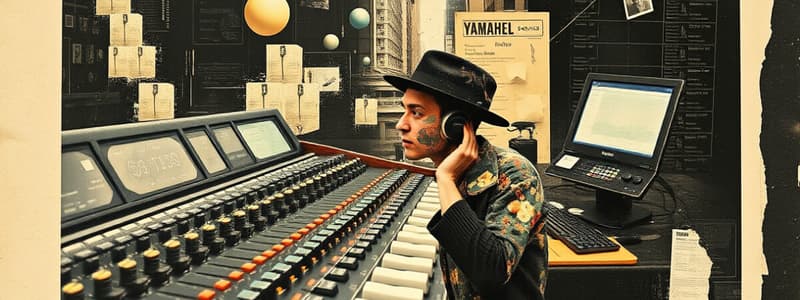Podcast
Questions and Answers
What is a key difference between the CL and QL digital mixing consoles?
What is a key difference between the CL and QL digital mixing consoles?
- The QL has built-in mic pre's. (correct)
- The CL has a single version available.
- The CL has a total of 34 faders.
- The QL is a system based on a digital snake.
How many mono input channels can the QL5 mix at once?
How many mono input channels can the QL5 mix at once?
- 64 mono input channels (correct)
- 32 mono input channels
- 34 mono input channels
- 16 mono input channels
Which feature is shared between both the QL5 and QL1 consoles?
Which feature is shared between both the QL5 and QL1 consoles?
- 8 Matrix outputs
- Number of faders
- 32 mic or line analog input ports
- Total of 12 User Defined keys (correct)
What is not included in the rear panel of the QL5?
What is not included in the rear panel of the QL5?
Which of the following can both QL models utilize?
Which of the following can both QL models utilize?
What is the total number of stereo input channels that the QL1 can handle?
What is the total number of stereo input channels that the QL1 can handle?
What component is used to interface between the QL and QL Editor?
What component is used to interface between the QL and QL Editor?
Which button function is available on both QL models for adjusting output channels?
Which button function is available on both QL models for adjusting output channels?
Flashcards are hidden until you start studying
Study Notes
QL Digital Mixing Console Overview
- Developed by Yamaha Commercial Audio, QL series is based on CL technology, sharing components and design.
- Both QL and CL series feature the same mic preamps, touchscreen interface, faders, and Premium Rack operation system.
- QL is an integrated all-in-one system with built-in mic preamps, unlike CL which operates on a digital snake system.
Models and Features
- Two models available: QL5 and QL1, both compatible with R Series I/O racks.
QL5 Specifics
-
Front Panel:
- Equipped with 34 faders for mixing.
- Supports up to 64 mono input channels and 8 stereo input channels.
- Utilizes Fader Bank buttons for easy channel access.
- Contains 16 Sends On Fader buttons for accessing 16 mixes and 8 matrix outputs.
- Selected channel controls for tweaking input/output channels.
- Features a Touch And Turn knob for parameter navigation.
- 12 User Defined keys for custom shortcuts and menu access.
-
Rear Panel:
- 32 mic/line analog input ports.
- 16 line level outputs.
- Network port for interfacing with QL Editor and QL StageMix.
- 64x64 Dante ports for audio networking.
- 2 MY card slots for additional expansion.
- Includes 2-track AES/EBU connector, GPI port, Word Clock In/Out, and MIDI In/Out.
QL1 Specifics
-
Front Panel:
- Features 18 faders for mixing.
- Supports up to 32 mono input channels and 8 stereo input channels.
- Includes Fader Bank buttons for channel navigation.
- Comprises 16 Sends On Fader buttons for managing 16 mixes and 8 matrix outputs.
- Selected channel controls for input/output adjustments.
- Touch And Turn knob for parameter adjustments.
- 12 User Defined keys for personalized shortcuts and navigation.
-
Rear Panel:
- 16 mic/line level analog input ports.
- 8 line level outputs.
- Network port for QL Editor and QL StageMix interaction.
- 32x32 Dante ports for network audio.
- 2 MY card slots for expansions.
- Includes 2-track AES/EBU connector, GPI port, Word Clock In/Out, and MIDI In/Out.
Future Content
- Upcoming videos will focus on specific functions of the QL Series.
- Similarities between CL and QL series will result in some shared content in training materials.
Studying That Suits You
Use AI to generate personalized quizzes and flashcards to suit your learning preferences.
